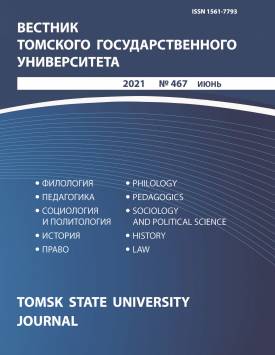The Content of the Self-Plagiarism Concept
In the article, the author discusses the questions posed in scientific literature that have no satisfactory explanation either in the copyright doctrine or in the arbitrage practice: Should the rules for citing works be followed when using your own work in your other work (self-citing)? Is it possible to qualify citing of your own work (self-citing) without indicating its author as plagiarism (selfplagiarism)? The aim of the article is to identify legal features characteristic of the notions of self-citing and self-plagiarism, and to reveal the legal nature of self-plagiarism based on these notions. Citing is using a part of a work (or the whole work) which is protected by copyright by reproducing it in a different work in order to disclose (explain, comprehend) the author’s idea connected with the idea of the author of this different work. Based on this, citing rules should be used when an author is citing his/her own work in case this author does not have an exclusive right to the work or the right to use the work by means of reproduction or public performance. Thus, the author who has an exclusive right to a work or the right of reproduction can reproduce his/her own work in another work without indicating the name of the author of the work used and without complying with citing conditions. This situation cannot be considered as citing (Art. 1274, the RF Civil Code). The analysis of Russian and foreign scholars’ views on the content of self-plagiarism shows that its general definition comes down to the idea that self-plagiarism is the repeated publication of an author’s own work as a new one by this author (without indicating his/her authorship). It is hard to agree with this position because reproduction of his/her own work by the author without the consent of the copyright holder leads to an infringed exclusive right to a work but not the copyright. Based on this, the main features of plagiarism are: (2) non-creative nature of mental activity; (2) expression of the form of presenting a thought (form of work) created by the creative work of another author (co-authors) in any objective form; (3) recognition of one’s authorship for the form of presenting a thought created by another author (co-authors). The author comes to the conclusion that there is no legal basis for qualifying author’s actions to reproduce his/her own works in his/her other work without specifying the name of the author as plagiarism (self-plagiarism).
Keywords
author,
work,
citing,
self-citing,
plagiarism,
self-plagiarismAuthors
| Vitko Viacheslav S. | Tomsk State University | vitko_v_s@mail.ru |
Всего: 1
References
Пушкин А.С. Полное собрание сочинений : в 10 т. 3-е изд. Т. 5: Стихотворения (1827-1836). М. : Изд-во Академии наук СССР, 1963.
Чулков Г.И. Жизнь Пушкина. М. : Вече, 2017.
Понкин И.В., Редькина А.И. Цитирование как метод сопровождения и обеспечения научного исследования. М. : ИНФРА-М, 2019.
Витко В. С. Критерий допустимого объема цитирования произведений // Патенты и лицензии. Интеллектуальные права. 2019. № 5.
Гаврилов Э.П. Интеллектуальные права: есть над чем поразмыслить // Патенты и лицензии. Интеллектуальные права. 2019. № 11.
Козлова Н.В. Оригинальность и самоцитирование в произведениях, содержащих результаты исследований по юридическим наукам // Патенты и лицензии. Интеллектуальные права. 2019. № 8.
Котляров И.Д. Самоплагиат в научных публикациях // Научная периодика: проблемы и решения. 2011. № 4.
Чайков М.Ю., Штенников В.Н., Зяблова А.Ю. Что такое «самоплагиат» // Правовая защита, экономика и управление интеллектуальной собственностью : материалы науч.-практ. конф. Екатеринбург, 21 апреля 2015 г. Екатеринбург, 2015. Т. 2.
Кривин Д.В. Понятие, отличительные признаки и характерные особенности отдельных видов плагиата // Экономика и менеджмент инно вационных технологий. 2017. № 5. URL: http://ekonomika.snauka.ru/2017/05/14783 (дата обращения: 02.10.2020).
Челышев М.Ю., Арсланов К.М. Несанкционированные заимствования в российских и германских квалификационных исследованиях по праву: российское и немецкое законодательство, судебная практика // Вестник гражданского процесса. 2013. № 1.
Гаврилов Е. К вопросу о самоплагиате в произведениях науки // Интеллектуальная собственность. Авторское право и смежные права. 2019. № 10.
Scanlon Patrick M. Song from myself: An anatomy of self-plagairism. Plagiary: Cross-Disciplinary Studies in Plagiarism, Fabrication, and Falsification. 2007.
Streefkerk R. What is plagiarism? URL: https://www.scribbr.co.uk/category/academic-dishonesty/(accessed: 25.09.2020).
Roger C. Self-Plagiarism and Self-Citation: A Practical Guide Based on Underlying Principles. URL: http://www.rogerclarke.com/SOS/SCSP- 09.html (accessed: 02.10.2020).
Roig Miguel. Avoiding plagiarism, self-plagiarism, and other questionable writing practices: Aguide to ethical writing. Retrieved from URL: http://facpub.stjohns.edu/~roigm/plagiarism.doc (accessed: 02.10.2020).
American Psychological Association. The Publication Manual of the American Psychological Association. Sixth Edition. Washington, D.C. : American Psychological Association. 2010.
Hexham I. On Plagiarism and Integrity in Scholarly Activity Humanist: Humanities Computing 5, 4 (3 April 1992). URL: http://www.ucalgary.ca/~hexham/study/plag.html (accessed: 29.09.2020).
Витко В. О признаках понятия «плагиат» в авторском праве. Ч. I // Интеллектуальная собственность. Авторское право и смежные права. 2017. № 2.
Витко В. О признаках понятия «плагиат» в авторском праве. Ч. II // Интеллектуальная собственность. Авторское право и смежные права. 2017. № 3.
Витко В.С. О признаках понятия «плагиат» в авторском праве. М. : Статут, 2017.
Hexham I. The Plague of Plagiarism. 1999. URL: http://c.web.umkc.edu/cowande/plague.htm
Ожегов С.И. Толковый словарь русского языка : ок. 100 000 слов, терминов и фразеологических выражений / под ред. проф. Л.И. Скворцова. 27-е изд., испр. М. : Мир и образование, 2018.

